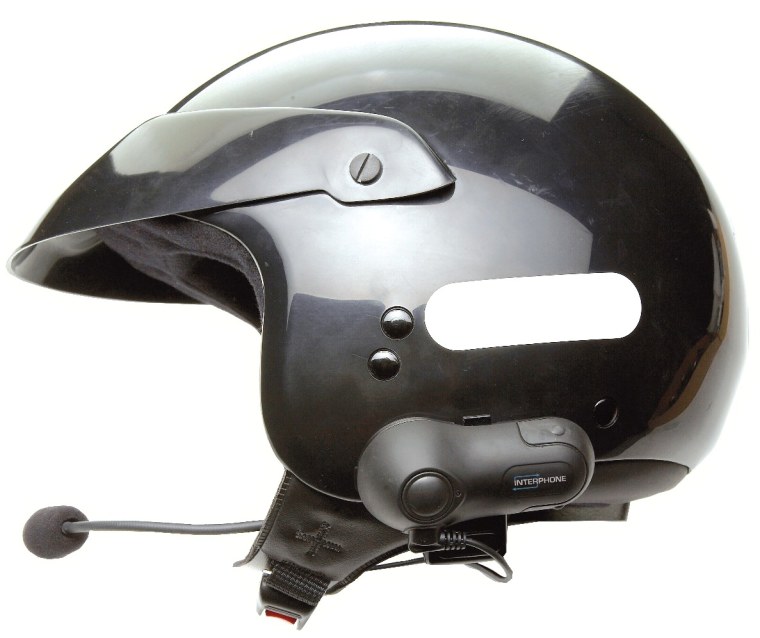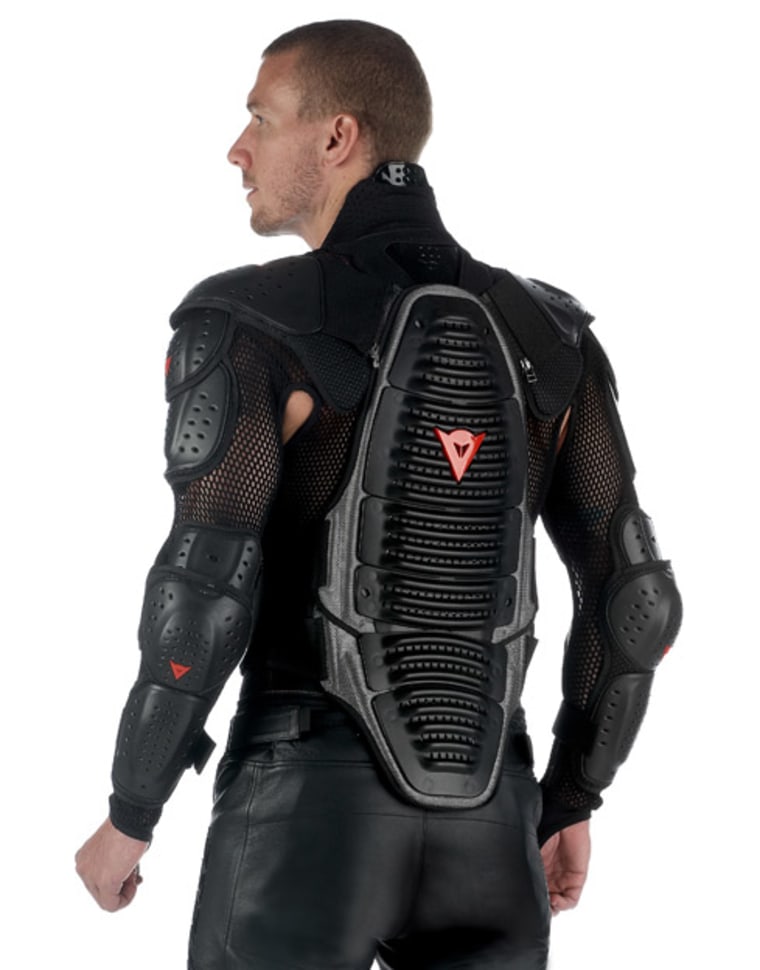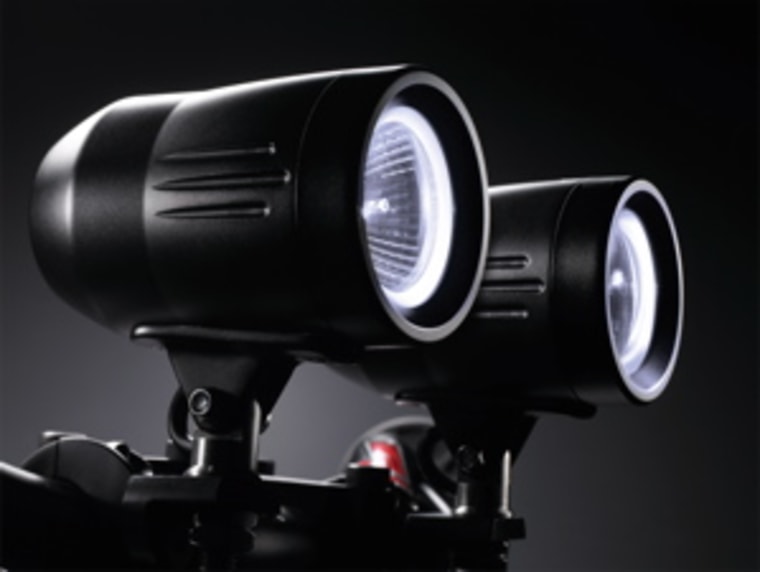Think of motorcycle gear, and fringed saddlebags and leather jackets might come to mind. But today’s riders can trick out their bikes with GPS, digital gauges and Xenon HID auxiliary lighting, and outfit themselves with protective gear that looks like it’s right out of science fiction.
First, though, to the machine. The new BMW R 1200 GS adventure touring bike (around $14,600) is a veritable poster child for advanced moto tech. If you saw Ewan McGregor and Charley Boorman’s grueling transcontinental odysseys, “Long Way Round” or “Long Way Down,” the R 1200 GS was their choice to get them through some particularly hostile territory.
Far from a stripped-down, overgrown dirt bike, the R 1200 GS is bristling with advanced technology including an on-board computer, integral ABS, tire pressure monitor and electronic suspension adjustment.
As an avid rider and technology junkie, I regularly lust after such a machine. However my reality is a 1989 Honda Transalp; a versatile, dependable bike. But in 1989, its most advanced feature was the futuristic typeface of the graphics adorning the plastic fairings.
Fortunately, any bike and rider can enter the 21st century one step at a time, one piece of gear at a time.
High Intensity Discharge lights
Lights perform dual roles on any bike: they let you see better and they make you more visible to others. My headlight casts a sad, feeble yellow beam. The first upgrade I wanted to make was some auxiliary lighting — some very bright auxiliary lighting.
The bulk of my riding is on the mean streets of Chicago and any urban setting is similar. One of the keys to survival is to be as obvious and noticeable as possible. PIAA’s Cross Country HID (High Intensity Discharge) driving lights ($550) are notable for being stunningly bright.
HID lighting uses gas instead of a filament as the lighting medium. HIDs are the bright lights with a blue-ish white tint seen often on expensive European cars.
Not only are the PIAA Cross Country lights conspicuous to other drivers, they also have a powerful driving beam — long and narrow — that extends sight distances.
Traveling at expressway speeds with these lights fired up made me feel much safer and kept me from over-driving my headlights, meaning that the stopping distance is farther than can be seen with the headlights.
Installation was surprisingly straightforward using the supplied wiring harness. Many HID lights require a separate component called a “ballast” for each light. The Cross Country lights manage to squeeze the ballasts into their 2-inch-diameter housing. The heavy aluminum enclosures can be mounted many different ways with optional brackets.
The information to pay close attention to when selecting lights is the total energy requirement. Every bike has a total amount of electrical power generated by the alternator. After subtracting the draw of running lights, headlight, cooling fan, among other components, the excess power is available to run add-ons including lights.
I only had 120 watts of juice to spare and the PIAA lights only needed a total of 70 watts.
A handy calculator for determining your bike’s excess electrical power is at Powerlet’s Web site in their support section.
Bluetooth helmets
Bluetooth, a short-range wireless networking standard, is also making motorcycle communication easier and safer.
I never use a hands-free phone on a bike in the city. It’s difficult enough keeping an eye on every possible hazard without any distractions. If I’m on a trip, cruising far away from traffic, I’ll use the phone feature.
Several companies make helmets with integrated Bluetooth systems. Nolan and Dainese are two companies with popular models.
The Dainese Airstream D-NECT ($599) edges out Nolan’s less expensive N-Com series with a lighter, full-face helmet that’s considerably quieter at expressway speeds. The Airstream is an incredibly comfortable, well-ventilated helmet with excellent peripheral views.
The Bluetooth interface with a cell phone (that has Bluetooth, of course) is decidedly simple; one button, easily pressed with a gloved finger, on the left side of the helmet controls calling and volume functions.
There is a slight learning curve involved since different actions require different presses. Audio quality was excellent on both ends of the call.
During testing, I found the D-NECT got most the most use paired with a Bluetooth-equipped Garmin zumo 550 GPS. Audio turn-by-turn directions are a perfect fit for the technology.

If you’re not in the market for a new helmet, BlueAnt offers the add-on Interphone ($190) Bluetooth kit.
The Interphone’s small module clamps or sticks to the outside of a helmet, along the bottom of it. The speaker and microphone require a simple installation without any cutting of the interior padding, and the kit is compatible with either an open or full-face helmet.
Audio and call quality were excellent, on par with Dainese D-NECT, even while I used the system with an open-faced helmet. With the wind hitting the exposed microphone, the person on the other end of the call could barely detect any noise.
The Interphone uses an automatic level adjustment for the speaker, depending on the amount of wind and other ambient noise.
For those of you who ride with a passenger, both the D-NECT and Interphone support intercom communication between two people, as long as both people have the equipment.
Getting the charge you need
Powerlet, mentioned above, is also the home of power outlets specifically designed for motorsports. The outlets look like smaller versions of a cigarette or cigar adapter, and Powerlet products are designed to withstand the vibrations and environmental conditions unique to motorcycles.
Powerlet outlets are offered by several European motorcycle companies, including BMW and Triumph, as optional equipment, and a wide variety of DIY kits are available.
My bolt-on Powerlet outlet ($125) was already supplying electricity to a budget Lowrance XOG GPS, but I wanted to be able to charge my cell phone on longer trips.
Digging into the treasure trove of adapter cables and kits on Powerlet’s Web site, I configured a set-up using their Luggage Electrix products that adapts any tank bag, allowing me to charge an iPod, phone, GPS unit and more inside the bag.
That single Powerlet outlet adorning my handlebars was the most useful, affordable addition I made to the bike.
GPS for bikers
The Lowrance GPS served me well, but I was curious to see how Garmin’s deluxe zumo 550 ($850) performed.
I had already experienced the convenience of the 550’s Bluetooth while testing the Dainese D-NECT rig.
The zumo is one of a very few GPS models designed specifically for motorcycle use. That means large, glove-friendly buttons designed for easy left-hand operation of the touchscreen, a military-specification waterproof housing and a build that withstands severe vibration.
The screen is bright enough for outdoor visibility, while I had to cup my hand around the Lowrance’s screen to see it. The included zumo mount, a costly accessory at $85, seemed durable and allowed different mounting positions.
Satellite lock-on typically took just under 20 seconds, one of the fastest I’ve tested, and the included U.S. maps have points of interest included.
If you are planning on keeping the unit charged with a Powerlet outlet, a Powerlet mini-USB cable is the only accessory not included. Otherwise, you can make a connection directly to your bike’s battery with the supplied cables.
Tech apparel
ATGATT, or “All The Gear, All The Time,” is a safety approach to how a rider dresses that is in contrast to the lighter weight wearing of jeans, T-shirt and running shoes.

Dainese, an Italian pioneer in protective gear, was the first company to create back and neck protection systems. Their gear is tested and tuned with the help of pilots such as MotoGP superstar Valentino Rossi, and the technology has trickled down to their line of retail products.
The company’s V Neck Wave jacket ($469) looks like the exoskeleton of a human-size bug. An articulated neck support lessens fatigue from the wind, and guards the cervical area of the spine. While most protective jackets stop at elbow and shoulder pads, the V Neck Wave adds forearm, chest and neck-to-tailbone back armor.
The heavy mesh that connects the padding adds seasonal versatility to the setup: Wear the V Neck over a long-sleeved wicking base layer during hot summer months, then add a wind-proof, insulated shell for late or early season riding.
I felt fully protected, confident and unencumbered during testing. For the first time, I wasn't worried about my neck, which I’d injured in an accident earlier this year.
Italians know their bikes and gear. Sidi makes world-class cycling and motorcycle footwear that embodies bold design and innovative materials.
The Vertigo Rain boot ($325) incorporates many of the fit and safety features of the more expensive Corsa and upcoming Vortice models in an all-weather package.
With looks that rival an Aprilia race bike, the Vertigo Rain boots have extensive heel, toe, Achilles tendon, shin and ankle protection. Nearly all the components of boot are easily replaceable with a screwdriver.
As a vegetarian, I'm always on the lookout for effective, man-made materials in my gear — not always an easy task in leather-dominated footwear.
Sidi uses a synthetic called Lorica which is stronger and lighter than leather. An interior membrane kept the boots watertight without suffocating my feet throughout testing.
High-tech shades
Sun glare is a tricky problem to deal with on a motorcycle. Clear shields can be swapped with tinted versions, but taking off a shield is inconvenient. Changing conditions make any product, including sunglasses, only a temporary solution.
Wiley X makes tactical glasses and goggles favored by many military personnel. That includes the company’s Jake glasses ($135) with light-adjusting, shatter-proof polycarbonate lenses, the best riding eye wear I've tried yet.
The fit is secure for most face sizes and the high-density, replaceable foam gaskets seal out dangerous debris. My previous glasses would fog up on chilly mornings, but Wiley's stayed clear because of the cleverly designed ventilation along the top of the foam. Best of all, the light-adjusting lenses change from clear to very dark — no fussing with lens changes.
Now, I must get back to channeling my inner Charley Boorman. Ride safely.
